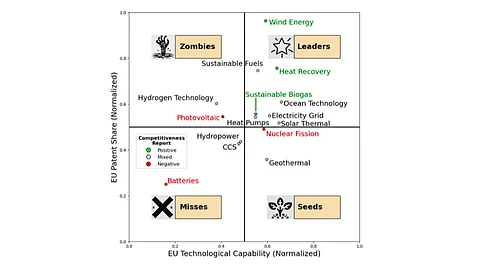

An EU study shows it has strong competitiveness in wind, heat recovery, and ocean energy, but warns solar PV is in the ‘Zombie’ category
Despite high patent activity, EU solar PV struggles to convert innovation into manufacturing strength, losing ground to China
Technological capability, not patent volume alone, is a better predictor of future competitiveness, says JRC
A new European Union (EU) study uses patent data and economic complexity analysis to assess the bloc’s competitiveness in clean technologies. Findings suggest strong European prospects in wind, heat recovery, and ocean energy, but raise concerns over solar PV’s ability to translate innovation into manufacturing strength, placing it in the ‘Zombie’ category.
Conducted by the European Commission’s research arm, Joint Research Centre (JRC), the study assesses the potential for 15 net-zero technologies under the EU’s Net Zero Industry Act (NZIA) using patent data. The method was cross-checked with an independent analysis of the JRC’s Clean Energy Technology Observatory.
According to the JRC’s assessment, photovoltaics or solar PV falls in the ‘Zombies’ category, which means that despite a high level of patenting and research activities, it is not likely to translate into manufacturing competitiveness and generate economic returns.
In the 4 quadrants that the report places these various technologies, solar PV also finds itself marked in red alongside nuclear fission and batteries, meaning these have an overall ‘rather negative competitiveness judgment’.
The report writers also point out that the EU once led in solar PV but lost its position after China first surpassed it in technological capability in 2004, then overtook it in 2008 in terms of PV cell and module production. Today, China is known as the world’s largest solar PV factory, while the EU targets 30 GW of PV manufacturing along the entire value chain by 2030 (see €480 Million For European Solar PV Partnership).
“While this analysis was not carried out systematically and thus remains illustrative, it provides evidence on how technological dominance in terms of patenting should not be interpreted as a guarantee for future competitiveness, which is better captured by the evolution of technological capabilities,” explain the researchers.
Nevertheless, they add that a low capability score does not mean a technology should not receive EU policy support, as strategic considerations like supply security may still justify it. The metric is intended to guide feasibility rather than dictate desirability.
On the other hand, the EU has high manufacturing competitiveness for wind, heat recovery, and ocean technologies. These are categorized as ‘Leaders’.
Among other technologies, batteries fall in the ‘Misses’ quadrant, suggesting that the bloc may find it difficult to become competitive in this technology even with further investment support. Both nuclear fission and geothermal come under the ‘Seeds’ category, which means that despite a medium-low patent share, the EU holds relatively strong capabilities to achieve competitiveness in this space.
Further analysis of subclasses shows that carbon capture and storage (CCS) appears overall to have low prospects, but the EU could become a leader in capture technologies even though it is weaker in storage and transport.
The complete JRC study titled EU competitiveness in net-zero technologies: Insights from patents and economic complexity is available for free download on the European Commission’s website.
